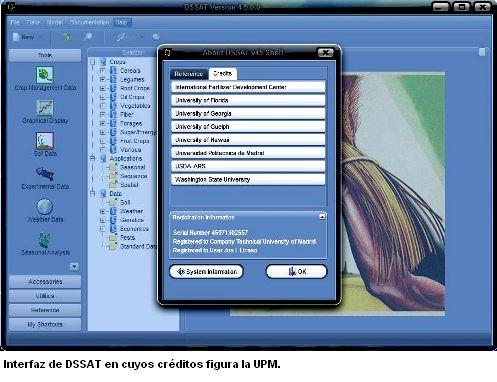Madrid, Spain
November 18, 2013
Investigadores de la Universidad Politécnica de Madrid participan en el desarrollo de una herramienta que, mediante modelos de simulación de cultivos, permite analizar opciones de manejo agrícola, estimar riesgos ambientales y mejorar el uso de recursos

Los modelos de simulación de cultivos son la base del Sistema de Apoyo a la Toma de Decisiones para la Transferencia de Tecnología Agrícola (DSSAT, por sus siglas en inglés), en cuyo desarrollo han participado investigadores del Grupo de Sistemas Agrarios (AgSystems) de la Universidad Politécnica de Madrid (UPM). Profesionales del sector agrícola usan este software desde hace años en más de un centenar de países, ya que permite realizar infinidad de experimentos virtuales para estudiar opciones que de otra manera no podrían hacerse. El próximo lanzamiento de la versión 4.6 incorporará mejoras en la estructura e interfaz de los modelos, en los análisis asociados y en las herramientas de apoyo.
¿Qué efecto tendría a largo plazo un cambio de laboreo en una determinada parcela agrícola? ¿Y un cambio de cultivos? ¿Y si se cambian ambas cosas? En la agricultura las opciones son incontables y la investigación de todas ellas con métodos tradicionales no resulta viable. Además, la Organización de las Naciones Unidas para la Alimentación y la Agricultura (FAO) prevé que en los próximos 40 años habrá que doblar la producción de alimentos, lo que obligará a examinar un gran número de opciones, con métodos científicos cuantitativos, y escoger las opciones que mejor se adapten a las condiciones de cada lugar.
Con vistas a responder a este reto se efectúo una investigación que evaluó el conjunto de modelos conocido como DSSAT. Las predicciones de estos modelos se compararon con la información proveniente de 16 años de estudio sobre el efecto conjunto del laboreo y las rotaciones de cereal. La producción del cereal, cebada, y sus rotaciones dependían exclusivamente de la variabilidad de las lluvias. Los modelos captaron bien las tendencias observadas y ayudaron a interpretar algunos resultados. La combinación de laboreo tradicional con una rotación cereal-leguminosa ofreció los mejores resultados. Pero el laboreo reducido mejoró la calidad del suelo en comparación con el laboreo tradicional. Estos aspectos ambientales, que en el corto plazo pueden pasar inadvertidos, pueden ponerse de manifiesto gracias a los modelos.
Los investigadores de AgSystems, vinculados a la Escuela Técnica Superior de Ingenieros Agrónomos, se han encargado de afinar la calibración, evaluación y desarrollo de estos modelos para ayudar a responder a los desafíos planteados, aplicándolos a las condiciones específicas de la agricultura española, incluso en ambientes donde la limitación de agua para los cultivos puede llegar a ser severa. Gracias a su trabajo, la UPM aparece entre las instituciones científicas responsables del desarrollo de la última versión del DSSAT, que incorporará nuevos programas de aplicación mejorados que evalúan los riesgos económicos y los impactos ambientales asociados a los modelos de cultivos.
Virtual farming to explore alternatives
Researchers at the Universidad Politécnica de Madrid (Technical University of Madrid) are involved in the development of a tool that, through crop simulation models, allows them to assess the integrated impact of environmental and management variables on productivity and resource conservation.
Researchers of the group AgSystems of the Universidad Politécnica de Madrid (UPM) have participated in the DSSAT which is the Decision Support System for Agrotechnology Transfer based on crop simulation models. Experts in Agro have used the DSSAT model in over 100 countries for years because it allows them to make countless virtual experiments to study alternatives not be possible another way. The upcoming release of the DSSAT v4.6 will incorporate new elements to enhance the structure and the interface of models as well as assessments and support tools.
What long-term effect would a tillage-rotation have in a crop? What about a change in crops? And what if we change both things? The options in farming are countless and its research is not feasible when using traditional methods.
In addition, the Food and Agriculture Organization of the United Nations (FAO) has estimated that we will have to double the food production in the next 40 years. Therefore, we must study alternatives based on quantitative scientific methods and we should select the best options according to the conditions of each particular place. With this purpose, a research assessed a group of models known as DSSAT. The model predictions were compared with the information of 16 years of research where the combined effect of tillage and rotations of cereal were measured. The cereal production, barley and their rotation depended exclusively on rainfall frequency.
The models captured properly the observed trends and were helpful explaining the results. The combination of conventional tillage with a cereal-legume rotation provided better results. However, the reduced tillage enhanced the soil quality compared to the conventional tillage. Those environmental aspects, which in a short-term are unnoticed, can show up thanks to those models.
A team of researchers of the School of Agricultural Engineers of the UPM has refined the calibration and the development of these models to meet the challenges also in order to use them for the specific conditions in the Spanish farming, even in environments where the water limitation for crops can be severe.
Thanks to this research, the UPM is one of the scientific institutions responsible for the development of the latest version of the DSSAT. It will incorporate new improved application programmes able to assess the financial risks and the environmental impacts related to crop models.